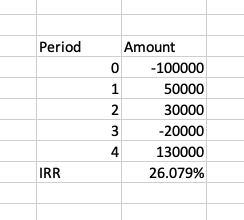On this page is an Internal Rate of Return calculator, or IRR calculator. Enter the cash flows of an investment (or planned investment) in evenly spaced periods, and the tool will tell you your periodized rate of return.
In the tool below, enter whether you are putting money into an investment using a negative number or receiving money back from an investment using a positive number.
IRR Calculator
What is the Internal Rate of Return or IRR?
IRR, or the Internal Rate of Return, is the interest rate (or sometimes, discount rate), making the net present value of all cash flows in an investment equal to zero. Thus, the IRR is the steady-state interest rate in a perfectly behaved investment that matches the real-life experience of cash flows.
IRR is useful both as a benchmark and to model for comparison with another investment. As a benchmark, it shows you how an investment, bond, or other cash-flowing instrument performed over time. With modeling, you have to estimate the future cash flows of an investment, which you can then compare to the naive return you think you'll receive from some other benchmark, for example, the S&P 500.
In the real world, it's hard to find an investment which perfectly returns money in uniform intervals. To set individual days for cash flows, use the irregular rate of return or xirr calculator.
The Difference Between Money Now and the Future
Whether it's time or money, we've only got some much – and when you are planning on spending either, you should be modeling potential outcomes. An IRR calculation can't help you much with time, but it can help you model out a few different scenarios for the future growth of your money.
Money today is more valuable than money in the future. That's true because modern monetary systems tend to drive inflation, but it's also true because sometimes you might be comparing an investment versus consumption – for example, a trip or a car. If no investment options are compelling, it might be worth the splurge!
IRR Formula
The formula for IRR (and NPV, if you don't set NPV to 0) is:
NPV=\sum_{n=0}^{N}{\frac{A_n}{(1+r)^n}}Where:
- NPV – net present value; here we set it to 0% to isolate the pure IRR
- n – the period the cash flow or amount came in
- N – the total number of periods
- A_n – the amount of the cash flow in a given period
- r – the internal rate of return
Note: r isn't always an annual rate, but it is a periodic rate. That is, if you aren't using years as your period, you will need to convert it when comparing to returns quoted ion years.
Example IRR Calculation
Let's walk through the default calculation in the IRR tool.
In this scenario, you invest $100,000 into an investment at time 0. In years 1 and 2, you receive payouts of $50,000 and $30,000, respectively. In year 3, you need to invest another $20,000 (consider a capital call for a private investment, or some other maintenance need). Finally, in year 4, you receive a final payout of $130,000.
0 = -100000+\frac{50000}{(1+r)^1}+\frac{30000}{(1+r)^2}-\frac{20000}{(1+r)^3}+\frac{130000}{(1+r)^4}As you can see, you get a result of over 26%. Assuming that's annual, compare that to an investment on the S&P 500, which might return 5-10% annually (although sometimes more!) in that time.
Calculating IRR in Microsoft Excel or Another Spreadsheet Program
Your first exposure to an internal rate of return calculation may have been through Excel or another spreadsheet program, but if not – I'll walk through it here. For the same scenario as above, create two columns, Period and Amount. Under those two, paste the following values (note that the first period is "0", no time has passed):
| 0 | -100000 |
| 1 | 50000 |
| 2 | 30000 |
| 3 | -20000 |
| 4 | 130000 |
Finally, underneath the "Amount" column, type =IRR(, then drag your cursor over all of the values in the "Amount" column. Hit return, and you should see the number you get in the tool – 26.079%.

IRR Calculations and More
IRR calculations are great for comparing a potential investment to an alternative investment or a hurdle rate. For example, by laying out the potential cash flows from an investment, you can see whether it makes sense to lock up your hard-earned money. Hopefully, the tool and the discussion helped you work through whether the investment fits your needs!
Here are some other tools which help you understand, reason around, or benchmark potential investments:
